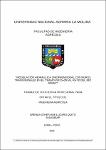Mostrar el registro sencillo del ítem
Modelación hidráulica unidimensional con muros transversales en el tramo km 25+000 al 40+700 del río Rímac
| dc.contributor.advisor | Ramos Fernández, Lía | |
| dc.contributor.author | Quito Susanibar, Brenda Sthefanie Lucero | |
| dc.date.accessioned | 2024-02-14T20:33:55Z | |
| dc.date.available | 2024-02-14T20:33:55Z | |
| dc.date.issued | 2023 | |
| dc.identifier.uri | https://hdl.handle.net/20.500.12996/6274 | |
| dc.description | Universidad Nacional Agraria La Molina. Facultad de Ingeniería Agrícola. Departamento Académico de Recursos Hídricos | es_PE |
| dc.description.abstract | En el presente trabajo de suficiencia profesional se expone el “estudio de diseño y modelamiento hidráulico para muros transversales” contemplado en el proyecto de recuperación progresiva de la reserva subterránea realizado en el río Rímac. Este proyecto tuvo como objetivo reducir la brecha existe sobre el servicio de agua potable que brinda la PTAP Huachipa, ya que actualmente solo se está produciendo 1,32 m3.s-1 y no el caudal de diseño de 5 m3.s-1; esto se mitigará mediante la recarga inducida artificial, donde se aprovecha el volumen de agua superficial en periodos de avenida con el efecto de la instalación de muros transversales y pozos tubulares. El diseño y modelamiento hidráulico de los muros transversales se realizó en el tramo km 25+000 al 40+700 del cauce del río Rímac. El modelo hidráulico se efectuó con el software HEC-RAS 1D en flujo permanente, para dos escenarios: uno en situación actual y otro para modelo con muros transversales. Para el diseño de los muros transversales se consideró un periodo de retorno de 100 y 500 años. Una vez definido las dimensiones y ubicaciones de estos muros se ingresaron al modelo hidráulico, y luego se evaluó el efecto generado por su colocación transversal en el cauce para un periodo de avenida y estiaje, con el fin de analizar si la variación del área mojada, tirante de agua, velocidad y número de Froude, representarían un beneficio para el incremente de la infiltración en el tramo de estudio. Finalmente, se corroboró que existe un incremento de 32 por ciento del área mojada con la implementación de los muros transversales, generando mayor área de contacto entre el flujo de agua y el suelo, es decir aumentando la variable principal para la infiltración. Obteniendo un incremento del 26 por ciento y 32 por ciento en los caudales de infiltración durante las temporadas de avenidas y estiaje, respectivamente. | es_PE |
| dc.description.abstract | In the present work of professional sufficiency, the “Design study and hydraulic modeling for transversal walls” will be presented. This is contemplated in the project for the progressive recovery of the underground reserve carried out in the Rímac river. This project aimed to reduce the gap that exists on the service of drinking water provided by the PTAP of Huachipa, since currently only 1,32 m3.s-1 is being produced and not the designed flow of 5 m3.s-1. This gap will be mitigated by artificially induced recharge, where the volume of surface water is used in flood periods with the effect of installing transversal walls and tube wells. The design and hydraulic modeling of the cross walls was carried out in the 25+000 to 40+700 km stretch of the Rímac river bed. The hydraulic model was carried out with the HEC-RAS 1D software in permanent flow, for two scenarios: one in the current situation and another for the model with transversal walls. For the design of the transversal walls, a return period of 100 and 500 years was considered. Once the dimensions and locations of these walls were defined, they were entered into the hydraulic model. Then, the effect generated by their transversal placement in the channel was evaluated for a period of flood and low water to analyze if the variation of the wetted area, depth of water, speed and number of Froude would represent a benefit for the infiltration increase in the section of study. Finally, it was confirmed that there is a 32 percent increase in the wetted area with the implementation of the transverse walls, generating a greater contact area between the water flow and the soil, that is, increasing the main variable for infiltration. Obtaining an increase of 26 percent and 32 percent in infiltration flows during the flood and dry season, respectively. | es_PE |
| dc.format | application/pdf | es_PE |
| dc.language.iso | spa | es_PE |
| dc.publisher | Universidad Nacional Agraria La Molina | es_PE |
| dc.rights | info:eu-repo/semantics/openAccess | es_PE |
| dc.rights.uri | https://creativecommons.org/licenses/by-nc-sa/4.0/ | es_PE |
| dc.subject | Cuenca del río Rímac | es_PE |
| dc.title | Modelación hidráulica unidimensional con muros transversales en el tramo km 25+000 al 40+700 del río Rímac | es_PE |
| dc.type | info:eu-repo/semantics/bachelorThesis | es_PE |
| thesis.degree.discipline | Acuicultura | es_PE |
| thesis.degree.grantor | Universidad Nacional Agraria La Molina. Facultad de Ingeniería Agrícola | es_PE |
| thesis.degree.name | Ingeniero Agrícola | es_PE |
| dc.subject.ocde | Pendiente | es_PE |
| renati.author.dni | 48480018 | es_PE |
| dc.publisher.country | PE | es_PE |
| dc.type.version | info:eu-repo/semantics/publishedVersion | es_PE |
| renati.advisor.orcid | https://orcid.org/0000-0003-3946-7188 | es_PE |
| renati.advisor.dni | 07462206 | es_PE |
| renati.type | https://purl.org/pe-repo/renati/type#trabajoDeSuficienciaProfesional | es_PE |
| renati.level | https://purl.org/pe-repo/renati/level#tituloProfesional | es_PE |
| renati.discipline | 811096 | es_PE |
| renati.juror | Ingol Blanco, Eusebio Mercedes | |
| renati.juror | Cavalcanti Cárdenas, Kenyi Glicerio | |
| renati.juror | Palomino Zegarra, Liz Margot |
Ficheros en el ítem
Este ítem aparece en la(s) siguiente(s) colección(ones)
-
IAG-RH Tesis [313]





